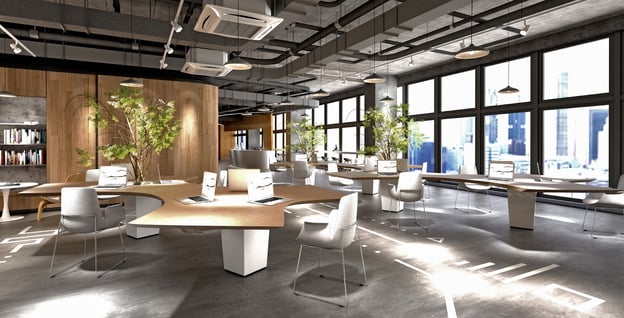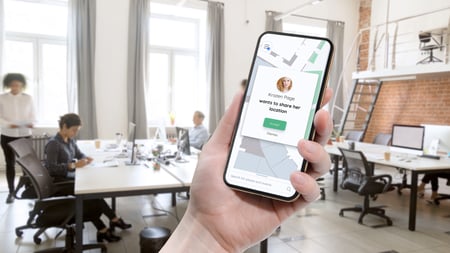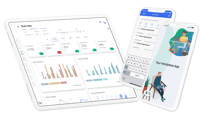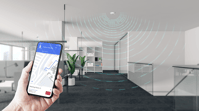Evolving from remote to hybrid working: is your workplace ready?
Eva Cheng
What we had imagined for the future of work for the next 10 years has happened in the past 2 years. The pandemic has undoubtedly accelerated workplace transformation.
During 2020, vast numbers shifted to remote working; some have found satisfaction in working from home, and some have realized the need to forge bonds, gain mentors, and collaborate face-to-face. In other words, it's almost impossible to find the perfect solution for everyone — therefore, the hybrid workplace has emerged.
|
Did you know? A recent report from Accenture found that 83% of respondents want to divide their time between - office and home. While a small number of companies announced that they are going back to the old way, 66% of global business decision-makers are considering rethinking their workspace strategy to enable a more hybrid work environment. |
This article will explore how Microsoft, Google, Amazon, and LinkedIn are adapting their return-to-office playbooks to the trend of hybrid working and how location technology can help enable a smoother hybrid workplace experience.
What is hybrid working?
First things first, a quick explainer of what a hybrid work environment actually is.
Hybrid work environments are those where the staff involved may all work partially from home and partially from the office (either on a fixed day basis or a fully flexible one), or where some members of staff are full-time in the office, and others are able to be more flexible.
In either scenario, a hybrid workplace comes with various pros and cons. In the plus column is the fact that a hybrid work environment can create a more dynamic office, with greater mixing between a wider range of staff than if everyone were stuck to a stationed desk. It also enables companies to downsize their real estate commitments, as they no longer need office space large enough to accommodate all staff at once.
On the downside, hybrid workplaces tend to need robust systems powering them in order to ensure spaces aren't overbooked, staff that needs to meet are in the office at the same time, and teams are still able to collaborate effectively.
Microsoft & Google: A Flexible Future
Two of the world's largest tech companies, Microsoft and Google, have wholly embraced hybrid working trends. Google expects most staff to spend three days per week in the office post-pandemic, with 20% of their 140,000 employees remaining fully remote for the indefinite future. Microsoft, on the other hand, has stated that it will adopt a hybrid strategy going forward. The question remains: what will happen to their huge corporate campuses?
In early May, Google CEO Sundar Pichai said that the "future of work is flexibility" and that Google was "reimagining a hybrid workplace to help us collaborate effectively across many work environments." This includes testing multi-purpose workplaces, enabling collaboration across campuses, and deploying a "hot desk" prototype that automatically adjusts to an employee's situation when they swipe their work badge.
Microsoft has provided its employees with technology tools to help them navigate remote and hybrid work environments, including prototyping their hybrid meeting spaces and deploying location systems around its workspaces, starting from its Redmond campus.
Google and Microsoft have always been pioneers in their office space. It stands to reason that the massive corporate campus will shortly move forward to a more hybrid, modern workplace environment.
|
Want to learn how to put together the perfect indoor location RFP for your business? Download our guide.
|
Amazon: Adjusting to More Flexibility
E-commerce giant Amazon initially intended for workers to return to the office part-time by September 7th but announced in August that the deadline has shifted to January 3rd, 2022. Amazon is one of many companies that insists that they would return to "an office-centric culture" as their baseline. However, they are adding more flexibility to their back-to-office plan, allowing each team director to decide when and how frequently the team should come to the office.
While health and safety concerns are likely the reason for this relaxed policy, it's also likely that employee sentiment plays a role. In the US alone, Amazon is looking to hire 40,000 corporate and tech jobs. As more workers demand more flexibility when they return to the office, it seems inevitable that Amazon will need to adjust itself to a more flexible workplace model to fit its hiring agenda.
LinkedIn: Fully Remote, Hybrid-Enabled
While LinkedIn initially expected all its employees would return to work at least 50% of the time as per a return-to-work policy cited in October 2020, they rolled back plans in July 2021 due to the increasing number of cases in the US.
In light of the new threat brought by the Delta variant, many companies are adjusting their back-to-office plan to hybrid working. As one of them, LinkedIn has embraced the idea and tested a new hybrid work model in their offices around the globe. They've been leveraging analytics data to learn how people have used the space or what they have been doing in the office. These insights enable LinkedIn to redefine its measurement of workplace success while improving its employee experiences as a whole.
Rethinking your office space for the future: how location technology can help
We are stepping into a new generation where the workplace is no longer present in a physical location. It is becoming more flexible and can adapt to both in-person and remote collaborations. Companies like Microsoft, Google, Amazon, and LinkedIn are leading the way in creating a more flexible work environment using technology to bridge the home-office divide. Many companies, therefore, are asking the ultimate question: how to plan a successful long-term hybrid work strategy?
To build a successful hybrid work model, you will need to identify the challenges and invest in the right technologies to achieve the flexibility and agility required in modern workspaces. Location technology can act as a foundation to enhance services needed in the era of hybrid working. The following are some use cases enabled by location services that can help facilitate a smoother hybrid work experience and deliver insights to create a long-term strategy for your workplaces:
Indoor-outdoor wayfinding to help your employees find their way to their desks, meeting rooms, and even car parks
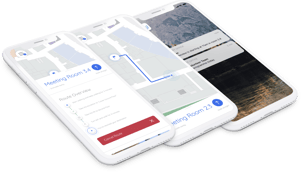 |
“Forget where you parked this morning? Click here to find your car via the fastest route.” |
If it takes 20 minutes to find a desk or a place to collaborate in the morning, frustrations can arise among your employees. Not to mention if you own a big campus, it'd be even more challenging for your employees or visitors to find their way across rooms, floors, and buildings.
One of the hybrid work models' goals is to make your employees' lives easier when they come to the office. By enabling accurate indoor-outdoor wayfinding and mapping systems on your campus, you can easily connect the dots between the physical locations and the digital world available on your employees' mobile devices.
Enhance your desk and room booking with indoor positioning systems
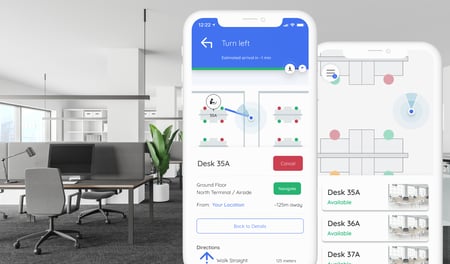 |
“Welcome to the Boston office! Click here to book the closest available desk and follow the route to get there.” |
A fixed seating plan and assigned daily supplies would no longer exist in a hybrid work model. Instead, hot-desking and flexible meeting rooms or private space booking will replace the static office plan.
To build a successful desk and room booking system, you will need an accurate and highly dependable indoor positioning system that can integrate seamlessly into your existing hardware infrastructure or software systems. Indoor positioning systems can help enable more accurate hot-desking and room allocation systems, complete with navigation solutions to guide employees and visitors across floors and buildings to their desks or meeting rooms with accessibility options.
Location sharing for more dynamic collaborations
|
|
“Your colleague, Joanne, wants to discuss your project. Click here to accept the meeting and share your location with her.”
“Your guests are arriving in 1 hour. Need help to book a meeting room and to share the location to guide your guests there?” |
A hybrid work model would be even closer to a home office than you imagine. People would tend to work or collaborate in more casual areas with comfortable chairs to put their feet up. The concept of a meeting room might become more windowless in a hybrid workspace, meaning that a tool that can help your employees and visitors meet when and where they want can be handy.
By enabling accurate indoor location sharing within the campus, your employees and visitors can easily find each other and arrange ad-hoc meetings flexibly and dynamically.
Complete peace of mind for employers and staff
When introducing technology into the workplace, data privacy and security are paramount for both employers and staff. It's essential to choose a technology that complies with standard data policies such as GDPR and CCPA. Even more so, you need to make sure the technology won't share the data without the users' consent.
At Pointr, we built our Deep Location® technology from the ground up. We ensure that our customers are entirely in control of their data. All data is secured (using services like Microsoft Azure), encrypted, and not shared with external entities or companies. Pointr's technology is ISO-compliant and trusted by our global clients and partners, including CBRE, DHS, and Cisco.
Enhance your workplace experiences with real-time location
We connect the dots between your physical workspace, IoT infrastructure, and your workplace app.
|
Combine your end-user experience platform… (your own workplace app or you’ve built an in-house app) |
with your IoT hardware…
(Bluetooth beacons, wifi AP, smart lighting, etc.) |
We help you activate location intelligence for better workplace experiences. (Bluedot, digital maps, wayfinding) |
|
|
|
|
Conclusion
The pandemic has forced many companies to rethink their approach and the design of the modern workplace. Hybrid working is likely to become the norm in the future. Location technology can seamlessly enable this new way of working, from hot-desking to smart parking and live location sharing for ad-hoc collaborations.
Modern campuses are already shifting towards more tech-enabled office spaces, and Pointr is live in three of the very largest and most cutting-edge campuses!
Get in touch with our team if you would like to know about the many ways location technology can change your campus as we return to work in 2023 and beyond.
Authors: Eva Cheng & Estelle Nagel
Eva Cheng
Eva is Pointr's Product Marketing Manager, meaning she's uniquely positioned to discuss the complex technology that powers Pointr's market-leading products in a way that dispels many of the myths around indoor mapping and location. She's also an expert in the indoor location market at large, making her an authority on the benefits and drawbacks of different and sometimes competing approaches to solving the challenges of accurate indoor positioning.




